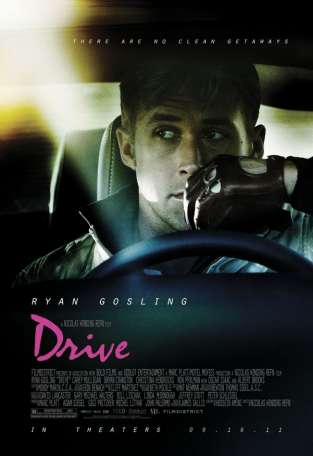By Michael Scoular (The Cascade) – Email
Date Posted: September 22, 2011
Print Edition: September 21, 2011
 Near the end of a sequence early on in Drive, a radio can be heard playing a basketball game in which the fans “are loving it, and they’re on their feet.” While the device plays a more important plot purpose than a possible self-referential one, the point is made, and accepted.
Near the end of a sequence early on in Drive, a radio can be heard playing a basketball game in which the fans “are loving it, and they’re on their feet.” While the device plays a more important plot purpose than a possible self-referential one, the point is made, and accepted.
It’s not often a movie begins so well, a slow and seductive buildup of audio and visual elements: the radio, a police frequency monitor, a ticking watch, the ever-present glow of orange and blue lights that cover the cars like a kind of modern day American Graffiti, and the tension of a silent, waiting driver, Ryan Gosling. Nicolas Winding Refn, in his first venture out into the mainstream, has brought with him an impressive array of talent: his direction of actors Gosling, Carey Mulligan, Bryan Cranston, and Albert Brooks with not a misstep among them; a visual style shot by Newton Thomas Sigel that does not call attention to itself, but its subjects; and a knowledge of how to shoot and edit action that seems lost on many modern directors.
While Drive’s name and inescapable motif suggest a certain genre, what sets this movie apart is its ability to capture human moments. In the mostly empty spaces occupied by characters, Refn’s camera repeatedly stops, taking in a situation and accentuating the fact that these people have unvoiced thoughts. In these moments of ambiguity, a pause gives life to what otherwise are soft or rarely speaking people and crass-mouthed, disgusting monsters. These sometimes startlingly long breaks express how those two types are not as definitive as we are used to in an action movie, and they do it better than the often average dialogue does (unsurprisingly, the bad guy gets all the best lines).
Intelligent, and a looker, Drive is. Passing streetlamps and illuminated dashboards are used to great effect, but perhaps most impressive is Refn’s use of nighttime aerial shots. Helicopter-establishing shots are often seen, but rarely noticed, due to how overused they are. However, their repetition says more about the setting than any location identifiers that come up in conversation do. The black night is an incredible mood setter, bringing to mind Michael Mann at his best, and so too is the exemplary soundtrack, made up of tracks from College, Riz Ortalani, and scored music by Cliff Martinez.
Drive’s handling of its expected car chase scenes is equally impressive. Steady shots are cut together in a manner that isn’t disorienting, but doesn’t tell the whole picture. Refn refuses to show his hand early in Drive, deciding instead to cut short potential police chases. The sequences we do see are impressive, but are economical in how they pack chase development and stunt work into scenes that avoid the expansive, ridiculous sequences in “bigger” action movies. While those looking for scenes comparable to those in The French Connection won’t be satisfied, Refn isn’t trying to hit that mark. His focus is primarily elsewhere, despite the presence of cars in almost every scene.
Unfortunately, Drive has its pitfalls. Carrying over from Refn’s previous work is a propensity for unnecessarily obscene violence, made even more repellant due to the use of CGI blood. While explosive shootouts and other acts of savagery are certainly not a bad element on their own, their incessant recurrence in the latter half of the movie deadens their impact. When key characters are affected by (or act out in) violence, because it is the fourth or fifth time such a type of scene has played out, there is a limit to its effectiveness. It’s worth noting that the most harrowing moments, involving a bullet and shadows, on their own don’t feature rampant blood splattering. Seeing how Refn can do action and violence and suspense without resorting to B-movie nonsense, the gore is simply overkill.
Hopefully with Drive, Refn has gotten the gratuitous killings out of his system, because otherwise, it is an impressive exercise in style, mood, and menace. Drive has the ingredients that could have made for something great, which is why its eventual excesses and the spoiling effect they have on what is otherwise a very carefully constructed, intensely restrained movie are so disappointing.

